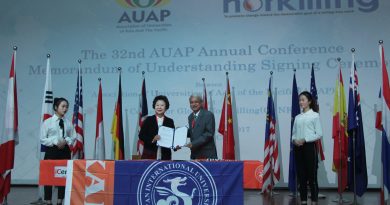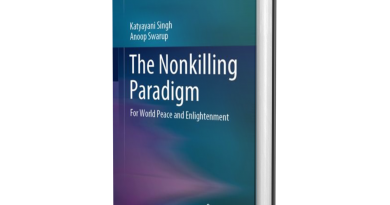Shifting the Way We Think About Nonkilling, by Anoop Swarup
The following article was published by Dr. Anoop Swarup in Vision of Humanity’s Economists for Peace site.
It is the timelessness of the precept, practice and pursuit of spirituality, nonkilling and nonviolent peace during our own Darwinian evolutionary process that gives hope to human civilisational ascent. Take recourse to the past 200,000 years since Homo sapiens evolved, which indeed has been an extraordinary journey. From our own primate roots with stone tools, we became insanely brilliant masterminds with complex language, control and computers to run the planet with agriculture and technology. The chief value of the scientific study of human origins and the evolution of rational thought and spirituality is that it nails the myth that ‘no human revolution can ever happen’ that may change human nature. The sudden and revolutionary emergence of language, consciousness, and culture but more importantly to perceive ourselves as others, our morality, ethics and spirituality that will foster universal nonkilling peace may well turn out to be our ultimate saviour.
It is a matter of record that in post-industrial age, atrocities such as genocides have been neither rare nor infrequent but rather enormous in their number, scale and scope. It reveals from datasets, that just in over 200 episodes of mass atrocities over the last hundred odd years there have been two such events per year, where governments alone have each killed at least 1,000 innocent civilians. The estimated fatalities are over a billion and the total does not take into account victims suffering collateral physical and psychological trauma perpetrated by state and non-state actors, as well as the military casualties, not to speak of causalities below the threshold and their economic consequences for the rest. In utter contrast, and on an individual human scale when we consider the past many centuries, it is estimated that less than 0.5 percent of all humans that ever existed actually killed others.
This was the finding of Glenn Durland Paige, founding Chair of the Centre for Global Nonkilling, in his seminal work, ‘Nonkilling Global Political Science’. Also, anthropological and other scientific evidence points out that in certain societies and cultures’ killing is down to statistically insignificant levels. In these circumstances let us ask, weather a reconciliation amongst humans and faiths and of science and spirituality for universal peace possible? A resounding ‘yes!’ is asserted at the Centre for Global Nonkilling at Hawaii that I now Chair. In my own talks and exchanges with late Professor Paige, it was apparent that he was influenced by the work of A. Richard Konrad who did challenge way back in 1974 the conventional assumption that readiness to kill from rape to holocaust was the only effective way to cope with the issue as violent problem-solving alternative rest upon three assumptions: that all nonviolent alternatives have been identified; that all have been tried; and that all have failed. From a spiritual perspective, a nonkilling society is a human community. It is characterised by no killing of humans, and no threats to kill; no weapons designed to kill humans and no justifications for using them; and no conditions of society dependent upon threat or use of killing force for maintenance or change.
The Institute for Economics and Peace defines Positive Peace as “the attitudes, institutions and structures that create and sustain peaceful societies.” By contrast, negative peace is the absence of violence and the fear of violence. It is my case in point that as a parallel analogy, nonkilling peace may also be recognised as ‘affirmative nonkilling’ that is positive and structural such as promoting education, learning and advocacy against killing. This is in contrast to ‘illusive nonkilling’ that is negative and non-structural such as fostering the concept of ‘a war to end all wars’ and capital punishment or coercive practices to achieve the ultimate goal against killings. Implicitly, a society with negative peace should not be witnessing crimes though living under oppression while societies characterised by Positive Peace could be witnessing human prosperity in terms of social and economic development. It is in this perspective and in today’s world of violence, killings and terror the question remains as to how we promote the objective of nonkilling peace through affirmative nonkilling. Perhaps, the institutionalisation and promotion of a ‘Global Nonkilling Index’ on scientific lines for sociological and societal introspection may best foster the paradigm of nonkilling peace and nonviolence amongst societies and the political leadership of countries.
Yes, for revolution to take place from our erstwhile Darwinian evolution we do need a utopian vision and mission. In this context it will not be out of context for me to delve briefly into the Kardashev scale, a measurement of a civilisation’s level of technological advancement, to adjudge even if vaguely humanity’s own civilisational ascent over the last millennia! It was physicist and futurist Carl Sagan followed by Michio Kaku, who suggested that humans may attain Type I status in 100–200 years, Type II status in a few thousand years, and Type III status, the most advanced status, in 100,000 to a million years. Unfortunately, the predictive interpolation and extrapolation perhaps took into account the energy requirement, technological prowess and scientific achievements but overlooked humanity’s own nonkilling creative potential and its spiritual attainments for universal peace. No doubt, the Centre for Global Nonkilling developing a Global Nonkilling Index in order to promote universal peace through affirmative nonkilling goes much beyond, using nonviolence as a narrative and a tactical approach by means of illusive nonkilling of the past, to develop a bold new principled and strategic paradigm of the future for holistic civilisational change.




